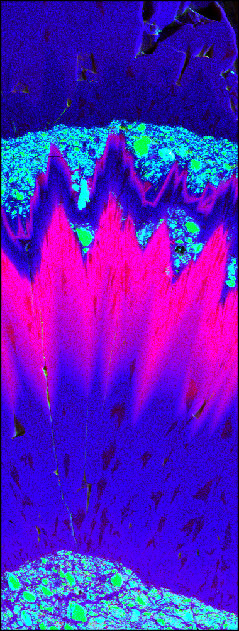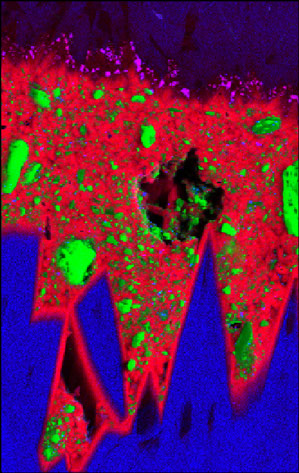- Home
- News
- Spotlight on Science
- Antarctic subglacial...
Antarctic subglacial volcanism and the global carbon cycle
03-10-2017
Volcanically-induced drainage of divalent iron-rich waters during the Last Glacial Maximum significantly contributed to the global carbon cycle. Evidence for this has been provided by micro X-ray fluorescence and XANES coupled to petrographic, geochemical and DNA studies of subglacial calcites from the East Antarctic Ice Sheet.
Share
Synchrotron radiation-based micro X-ray fluorescence (μXRF) and X-ray absorption near-edge spectrometry (XANES) have proven to be one of the most effective techniques to detect volcanic eruptions in continental calcium carbonate deposits found in caves (stalagmites) through concentration increase in sulfur (as sulfate) [1, 2]. Variations in crystal morphology and chemistry in successive growth layers record changes in climate, hydrology, solute concentration and particulates following eruptions [2] and environmental information can be placed into an absolute chronologic framework. In analogy to cave stalagmites, subglacial carbonates found in Antarctica provide a unique opportunity to investigate processes that occurred in the past at the ice-bedrock interface, including those associated with microbial metabolism. To date, Antarctic subglacial environments could be reached only by drilling through hundreds or thousands of metres of ice. But drilling has the potential to induce contamination of genomic properties preserved in the basal ice [3]. Subglacial carbonates found in Boggs Valley, East Antarctic Ice Sheet, grew in pockets of meltwater existing at the base of the glacier as a result of the combination of pressure-solution and geothermal energy. Their U/Th ages indicate that they formed during peak glacial conditions in Antarctica from 26.9±0.8 to 17.1±0.3 ka ago (Last Glacial Maximum). The calcites were found on ice-free bedrock, but during the Last Glacial Maximum the ice was estimated to have been 700 m thick to limit dispersion of geothermal heat flux to the atmosphere and sustain basal meltwaters.
Scanning electron microscopy with energy-dispersive X-ray spectroscopy revealed the occurrence of spherulitic crystals consisting of calcium fluoride, suggesting that waters rich in F invaded the subglacial system. It is likely that F is related to subglacial eruptions in the tectono-magmatic region of the Transantarctic Mountains. This hypothesis was tested at beamline ID21 by μXRF mapping of areas including all significant characteristics previously identified by optical and scanning microscopy. μXRF maps were acquired on double-polished, 300 µm thick wafers. Specifically, these analyses were focused on the layers containing calcium fluoride spherules. The valence state of Fe in the Antarctic subglacial calcites should reveal bio-weathering at the ice-bedrock interface resulting in the release of divalent Fe, a micro-nutrient available, upon discharge into the sea via subglacial transport, to phytoplankton. The delivery of bioavailable Fe to the Southern Ocean has important implications on the global C cycle: by boosting phytoplankton bloom, C is sequestered in organisms that, when they die, sink to the seafloor. This biological C-pump has been one of the most important processes responsible for lowering atmospheric CO2 during the Last Glacial Maximum. However, the mechanism of production, transport and delivery of the sub-glacially produced divalent Fe all the way to the ice-sheet margin has remained largely unknown.
Results from μXRF and XANES spectra helped to find a reasonable hypothesis for both production and transport mechanisms. The fluorescence signal of sulfur in Boggs Valley calcites is mostly yielded by sulfate (Figure 1), which, associated with fluorine, could be interpreted as being related to a common source that can be reasonably ascribed to the Trans Antarctic Mountain volcanism. In addition, XANES spectra displayed a low intensity peak at 2473.3 eV attributable to organic compounds, possibly amino acids (ref. cysteine). This potential evidence for microbial material prompted a study of bacterial amplicon sequencing, carried out at the Australian Centre for Ancient DNA. Thermophilic microbial species found in S-rich detritus-rich calcites (Figure 2) account for up to 47% of the DNA. These thermophilic taxa belong to phylogenetic groups that thrive at temperatures above 41°C. Furthermore, DNA data revealed the presence of microbes whose heterotrophic metabolic pathways was capable of releasing divalent Fe from the dissolution of silicates and pyrite oxidation.
 |
|
Figure 1. Distribution of S as sulfate (red) in the F-rich layer of Antarctica subglacial calcites. S has the highest concentration near a detrital-rich layer (green dotted portion) mostly consisting of silicates and Fe-rich particulate. (rendering: M. Cotte). |
A high level of sulfate and fluorine and evidence of thermophilic micro-organisms occur in calcite layers whose ages cluster around 23.5 ka. It is plausible that a hydrothermally-influenced subglacial lake formed following a subglacial eruption and then discharged into Boggs Valley at, or just before, 23.5 ka. This very likely resulted in the injection of high-energy waters into a subglacial system where divalent Fe was released via bio-weathering by heterotrophic microbes. High-discharge meltwaters flowing sub-glacially along the axis of glaciers that reached the sea, were then capable of delivering bioavailable Fe to the ice margin and may ultimately have contributed to driving changes in the global C cycle.
Synchrotron radiation μXRF maps and XANES spectra were fundamental to support the notion that Antarctic volcanism, by changing subglacial meltwater discharge of micronutrients, could potentially influence global climate.
Principal publication and authors
The influence of Antarctic subglacial volcanism on the global iron cycle during the Last Glacial Maximum, S. Frisia (a), L.S. Weyrich (b), J. Hellstrom (c), A. Borsato (a), N.R. Golledge (d,e), A.M. Anesio (f), P. Bajo (g), R.N. Drysdale (g,h), P.C. Augustinus (i), C. Rivard (j) & A. Cooper (b), Nature Communications 8, 15425 (2017); doi: 10.1038/ncomms15425.
(a) School of Environmental and Life Sciences, The University of Newcastle, Callaghan (Australia)
(b) Australian Centre for Ancient DNA (ACAD), The University of Adelaide (Australia)
(c) School of Earth Sciences, The University of Melbourne, Parkville (Australia)
(d) Antarctic Research Centre, Victoria University of Wellington (New Zealand)
(e) GNS Science, Lower Hut (New Zealand)
(f) Bristol Glaciology Centre, School of Geographical Sciences, University of Bristol (UK)
(g) School of Geography, The University of Melbourne, Parkville (Australia)
(h) Environnements, Dynamiques et Territoires de la Montagne, UMR CNRS, Université de Savoie-Mont Blanc, Le Bourget du Lac (France)
(i) School of Environment, The University of Auckland (New Zealand)
(j) ESRF
References
[1] S. Frisia et al., Journal of Volcanology and Geothermal Research 177, 96-100 (2008).
[2] S. Badertscher et al., Earth and Planetary Science Letters 392, 58-66 (2014).
[3] D.A. Cowan et al., Trends in microbiology 19, 540-8 (2011).




